7 Films With Symbolism You Didn't Notice (And Can't Unsee)

Every movie has subtext, but when it comes to the stuff that makes it to the top of the box office, that subtext is usually something like "violence is bad" or "blowing shit up rules" (often at the same time). Popcorn flicks are dumb as hell, is our point.
But as we've talked about once or twice in the past, some blockbusters have surprisingly rich layers of meaning hidden under all those one-liners and explosions. So let us once again be your Nicolas Cage to cinema's random bullshit clue which Benjamin Franklin stuck in a pipe or wooden leg or something, and reveal to you ...
Jurassic Park Is About Overcoming The Fear Of Becoming A Parent

The original Jurassic Park is full of rich themes, from examining the dangers of playing God to examining the dangers of underpaying and publicly berating the one guy who can keep your family and friends from being eaten by dinosaurs. One overt story element: Dr. Sattler (Laura Dern) is trying to convince Dr. Grant (Sam Neill) to have kids. The only stumbling block is Grant's love of pretending to disembowel children for his own amusement.
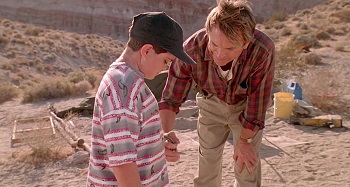
That kid grew up, got in shape, and learned to train velociraptors, all to get back at him.
Grant eventually comes around, learning that it's more fun to save children than to terrify them -- but as lecturer Mike Hill points out, this theme of creating family is repeatedly underscored in ways you probably didn't notice. For starters, the paleontological dig at the beginning has what's essentially an ultrasound machine, which Sattler and Grant react to like expectant parents.
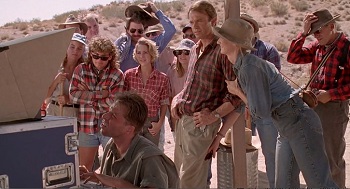
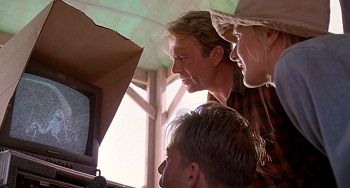
Not to mention how that is the daddest flannel shirt ever worn.
Then they witness an actual birth ...
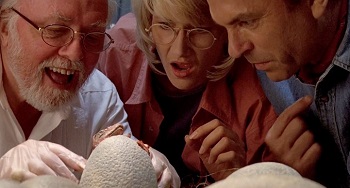
At which point the dinosaur immediately breaks out into "I'm The Baby, Gotta Love Me."
... which is followed by an emotional, maternal visit to a sick Triceratops. They even have to wade through its giant pile of shit, which is probably the most accurate depiction of what it's like to have a newborn ever on film.
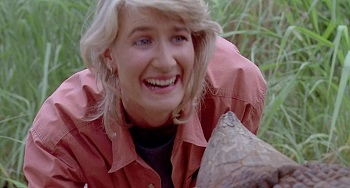
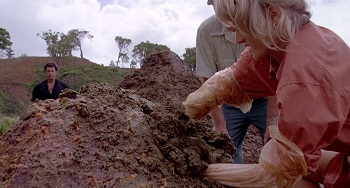
And Jeff Goldblum is there. It's uncanny.
When Dr. Grant decides that he likes kids and doesn't want to see two of them get eaten by a T. Rex, he rescues the girl by pulling her out of muddy wreckage -- which is disturbingly reminiscent of those childbirth videos they made us watch in school.

They stopped short of having the Jeep do Lamaze.
Then, the moment when Sattler discovers that Grant symbolically had kids by rescuing them is shot almost exactly like Grant's discovery that the dinosaurs are having kids earlier in the film, with the car as a sort of empty egg. According to Hill, this creates a "parallel between life finding a way socially, and life finding a way biologically." In other words, we can conclude that they probably "started trying" right there on the chopper out of the island.
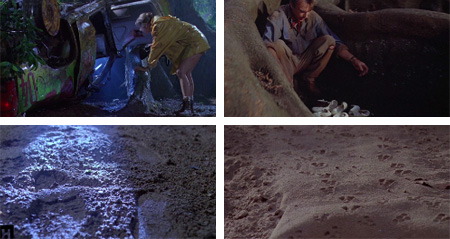
In Jurassic World, the theme of refreshing margaritas and delicious coffee is underscored by all the goddamn restaurant chains shoehorned into the story.
Tarzan Is Likely About The Writer's Crazy Pro-Eugenics Ideas

Saying that the story of Tarzan is problematic is probably an insult to problems. Even on the surface, it seems messed up. Tarzan is the uncomfortably pro-colonialist story of a white guy (a British lord by birth, in fact) who becomes the king of the African jungle. Even worse, in the world of the stories, "Tarzan" literally means "white skin." If the most recent movie version had been called The Legend Of White Skin, people would have lost their shit.
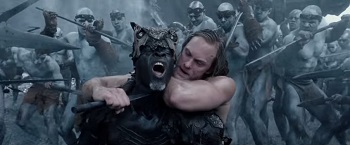
Meanwhile, "Jane" means "I don't have to have sex with an African woman."
One story even states that "the baiting of blacks was Tarzan's chief divertissement" (though The Erotic Adventures Of Tarzan had a different interpretation of this line). While this could all be viewed as run-of-the-mill old-timey racism, the Tarzan books may have had an even more sinister motivation. According to the biography Tarzan Forever: The Life Of Edgar Rice Burroughs, the famed author was a believer in eugenics and the forced sterilization of people deemed genetically inferior or undesirable. He advocated rounding up and killing not just criminals, but their families as well. In Burroughs' own words:

This Tarzan Vs. X-Men crossover sounds dope.
That kinda sounds like something the Nazis would say. In fact, they did. According to the book, Burroughs probably didn't side with them because of his "long-standing hatred of Germans." He hated everyone, basically.
With this understanding, it's hard to look at a white guy growing up in Africa to somehow become way awesomer than every African, using only the power of his whiteness, and not see it as an argument for racial purity. No wonder Disney had to use the smooth sounds of Phil Collins as a smokescreen for all the vile shit hidden in the story.
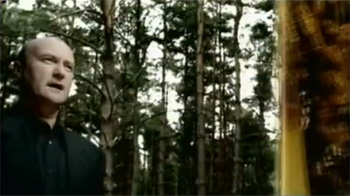
This might explain the movie's hit song, "The Moral Imbecile (Must Be Destroyed)."
Indiana Jones And The Temple Of Doom Is About Lucas And Spielberg's Divorces

Before Indiana Jones met aliens and survived a nuclear explosion by hiding in a flying kitchen appliance, Indiana Jones And The Temple of Doom was considered the oddest film of the franchise.
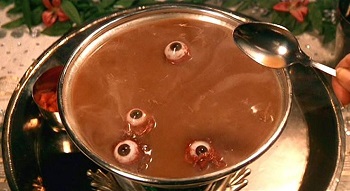
It's still the one you shouldn't watch while eating.
But why, exactly, was Indy's sense of fun and adventure from the first movie promptly replaced by a plot about child slavery and the sense that life is a steaming pile of dogshit? It seemingly all started with George Lucas' divorce. These days, Lucas might handle a split by simply using digital technology to erase his ex from all their home movies and replace her with Boba Fett, but back then, he let his pain seep into his work.
Lucas was able to convince Steven Spielberg to take the franchise in a darker direction after Spielberg, too, went through a bad breakup, turning this beloved series into the cinematic equivalent of listening to the Cure while eating a tub of ice cream. Take, for instance, the character of Willie. Indy's love interest goes from a capable partner to a shrill liability. The entire movie is her own personal gauntlet of embarrassment and failure.
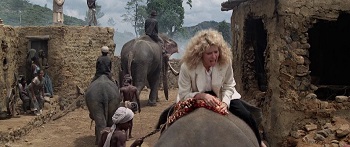
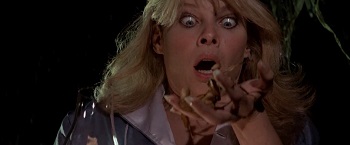
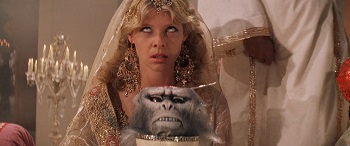
But the most bizarre part is that Spielberg later asked the actress to marry him, and she said "yes."
Whether she's failing to ride an elephant, getting attacked by insects, or the only one horrified by the crazy racist portrayal of Indian cuisine, it's not hard to theorize that the filmmakers were picturing their exes in these exotically shitty predicaments.
Most tellingly, what did the guys who felt like their hearts had been ripped out write into the movie? A guy literally getting his heart ripped out -- scarring children everywhere, but letting two dudes get something off their chests.
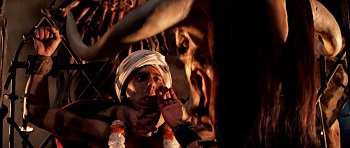
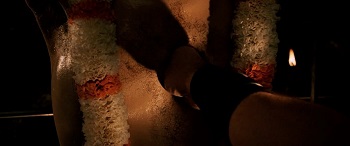
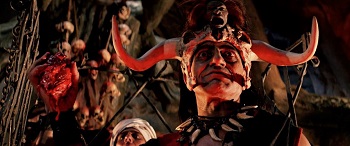
As in all divorces, it's the children who suffer.
Terminator 2 Is About Police Brutality

Until the day all of our smartphones and electric nose hair clippers become sentient and try to murder us, the Terminator movies will be enjoyed as fun popcorn fare. But they're much more than that. The first Terminator movie was steeped in Cold-War-era anxiety, an embodiment of America's fears of the inhuman, murderous foreigners powered by the metal endoskeleton of communism.
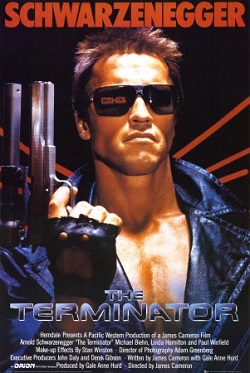
Red letters. We rest our case.
But by the time Terminator 2: Judgment Day rolled around, the Berlin Wall had already come down. So what political message is the sequel giving us? Well, at the beginning of the flick, it plays like a retread of the original. Arnold's T-800 is once again the big bad guy, and the T-1000 is seemingly the heroic human sent back to save the day. One's a clean-cut cop, the other's a hulking biker. But in what would have been a huge twist if you didn't see the trailer, poster, or action figures, it turns out Arnold is the good guy, and the cop is the shape-shifting villain -- because after the Cold War, it was time to examine America's internal problems. Like police brutality, for one.
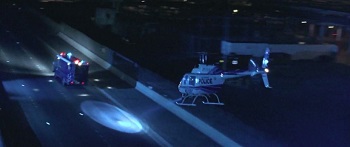
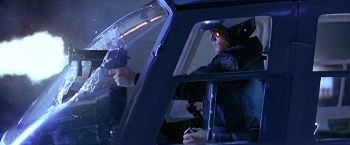
This was back when police choppers equipped with machine guns weren't standard.
If the image of a Los Angeles police officer repeatedly trying to kill a teenager doesn't seem politically motivated to you, James Cameron himself stated that the Terminator movies are ultimately about "losing touch with our own humanity, which allows us to kill and brutalize each other." So he picked a cop for the bad guy because, according to him:

"They are wrong, of course. The only inferior people are actors."
And you might not expect it from the guy who thought the world might be overtaken by cyborgs in 1997, but Cameron was surprisingly prescient in foregrounding this issue. The beating of Rodney King happened while T2 was shooting, and most insanely, happened across the street from the bar featured in the movie. According to Cameron, the first part of the Rodney King tape was footage of them making T2. And if you think that this movie wouldn't have subtextual elements to promote an agenda, remember that the tie-in song was done by Guns N' Roses. And where does Arnold keep his gun?
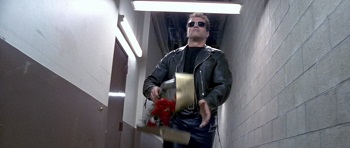
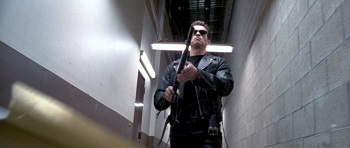
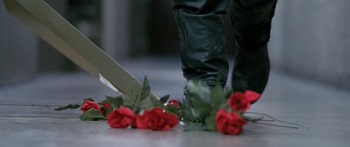
And what do machines have? Ax(e)ls.
Die Hard Is A Big Fuck You To Reaganomics

Die Hard: It's the thing that makes the Christmas season tolerable. But if you think the story of John McClane kicking ass in Nakatomi Plaza isn't one of the most important films of all time, you're sorely mistaken. You see, Die Hard is a rich sociopolitical allegory.
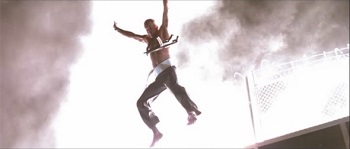
Which also, thankfully, has a crap-ton of gunfights and explosions.
It's all about Reaganomics -- President Reagan's economic strategy of cutting taxes and softening regulations for corporations -- which certainly has its critics. And yeah, one of them's a kickass action movie.
First off, John's wife Holly represents America. She's left behind the country's working class by separating from John -- we know he symbolizes the working class because he spends most of the movie in a filthy wifebeater, complaining about how fancy everything has become. Holly (America) has been corrupted and is now controlled by big business, symbolized by the watch Holly's new corporate overlords at the Nakatomi Corporation have bought for her.
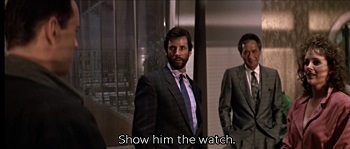
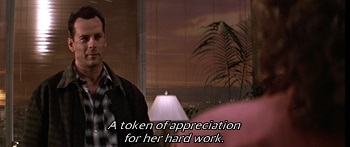
John's hairline represents the rapidly disappearing middle class.
Enter the greedy kidnappers, Hans Gruber and company. They represent the fears of critics of Reaganomics -- capitalism taken to the extreme. We repeatedly see similarities between Gruber and his corporate hostages. He owns the same suit as Takagi, and it's no secret that Gruber is a dark reflection of the sleazy Ellis.
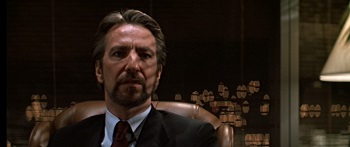
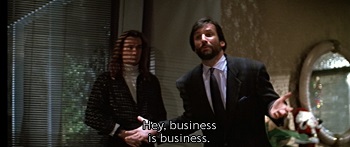
We're reasonably sure they passed the same prosthetic beard back and forth between takes.
At the time, President Reagan was famous for re-popularizing the idea of American Exceptionalism, even slipping the phrase "we are the exceptional nation" into a famous speech. This makes it particularly pointed when Gruber kidnaps Holly and says:
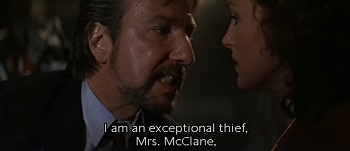
The only way for John and Holly to rid themselves of this mutant, evil form of capitalism (Gruber), is for Holly (who, again, is America) to reject her initial corporate offering by getting rid of the watch.
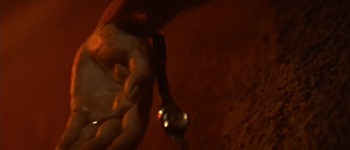
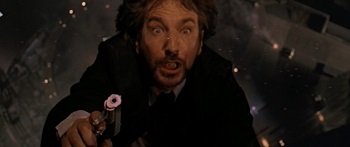
In the next movie, we'll find out that the watch had a brother, though.
The government's ineffectiveness in controlling the situation is seen in the characters of the FBI agents, who take charge but are comically terrible, play right into the villain's hands, and then die. The working-class guys, on the other hand, are all super smart -- John, Sgt. Powell, even the electric company guy who tries to warn the FBI not to shut off the power. On the other hand, every businessman, bureaucrat, or member of the media is either useless or pure evil.
And that is what Christmas is all about.
Labyrinth Has Strong Electra Complex Vibes

For those '80s kids who thought it was odd that they were first exposed to the contours of the male anatomy through a Muppet-filled family movie, this may help to explain things. The key to deciphering what Labyrinth's really about comes early on in the movie. We see that Sarah, the protagonist, has plastered her room with a bunch of newspapers clippings, like she's a serial-killer-hunting cop played by Morgan Freeman.

Freeman himself wasn't cast because his sexual tension with Bowie was too devastatingly erotic.
The stories are about Sarah's mother, who's absent from the movie, but was apparently an actress. They also mention her and her "on-off" romance with a fellow actor, whom we get a closer look at on Sarah's mirror.
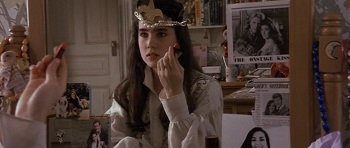
Hint: If she put the lipstick on the photos of the boyfriend, you'd get Ziggy Stardust.
That sure looks like David Bowie -- meaning that Sarah didn't conjure her image of Bowie's character, Jareth the Goblin King, after listening to "Rebel Rebel" during an episode of Jem And The Holograms. Jareth is her mom's boyfriend. So let's interpret that further, using Bowie's unnecessarily bulging junk as our guiding star.
The whole thing's a kind of Electra story, with Sarah creating a fantasy world to work through her attraction to her mom's boyfriend (a new father figure). Why else would she structure an elaborate fantasy world around him? The only way for her to ascend to sexual maturity (she refuses to date) is to destroy this surrogate father. He "has no power over her," because she doesn't literally want to sleep with some old dude.
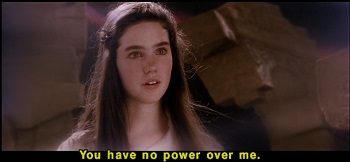
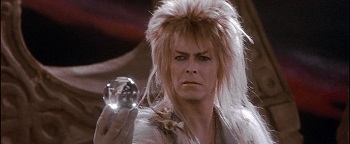
"But ... but my juggling routine ..."
The movie's novelization delves even further into this backstory, including scenes with the boyfriend, named Jeremy (which isn't far off from Jareth). In a flashback, he gives Sarah an evening gown and takes her dancing, which seems to explain this random-ass scene:
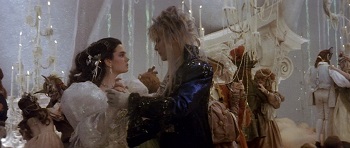
Beyond "Sure, let's just put the video clip in the middle of the movie for no reason."
They danced together, and that seemingly stirred up all kinds of confusing feelings in Sarah, and those feelings then naturally manifested themselves into two hours of sexual angst performed by Muppets. As they often do.
2001: A Space Odyssey Is Full Of Space Dicks And Space Vaginas

Embraced by both film scholars and drug-addled hippies, Stanley Kubrick's 2001: A Space Odyssey is a landmark of science fiction. Its almost impenetrable narrative has elicited a plethora of academic study. But for those who are intimidated by trying to piece together what the hell the black monolith is, or why a giant baby shows up at the end, here's a hidden theme we can all appreciate: It's full of space genitals.
Don't believe us? The movie's last part features a spaceship that resembles ... well, you don't have to be Sigmund Freud's urologist to figure it out.

A Q-Tip?
The ship fires out a tiny capsule ...
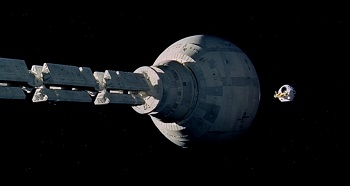
... which travels through a crazy tunnel ...

... and eventually transforms into a baby.
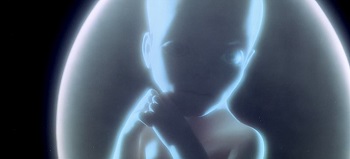
"No time for the old in-out, in-out, Dave."
Yup, it seems confusing and overly cerebral, but the movie's finale is telling the story of the origin of human life -- aka doing it. Looking back at earlier sections of the movie, there are similarly dick-like ships, and all the space stations seem pretty goddamn vaginal. Watching the ships dock is only a few guitar wahs away from an X rating.
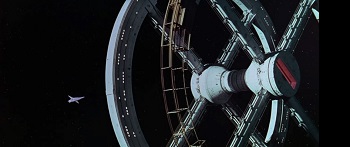
We'd embed the video, but we don't want to get you fired.
The crew of one ship are totally dressed like sperm ...
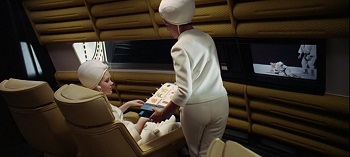
OK, Kubrick, now you can cast Woody Allen.
And if Georgia O'Keefe ever designed lunar spaceports, they'd probably look something like this:
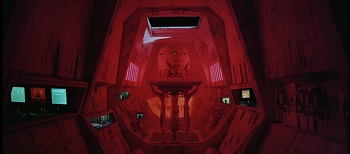
It should get those protuberances looked at, though.
Of course, this isn't the only sci-fi epic to use their space adventures as a metaphor for sex ...
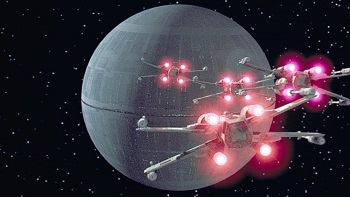
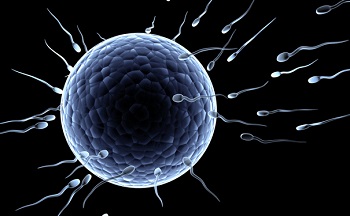
Obi-Wan is the bottle of wine that convinces you that you don't really need a shield generator this one time.
J.M. McNab co-hosts the pop culture nostalgia podcast Rewatchability, which can also be found on iTunes. Follow him on Twitter @Rewatchability.
Also check out 6 Books Everyone (Including Your English Teacher) Got Wrong and 7 Pop Culture Classics That Don't Mean What You Think.
Subscribe to our YouTube channel, and check out The Mind-Blowing Hidden Meaning Of 'Back to the Future', and other videos you won't see on the site!
Also, follow us on Facebook, and we'll follow you everywhere.